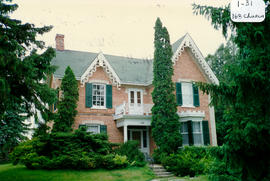- CA BWGPL GJ-HB-2017-03-28-01
- Item
- 1997
Part of George Jackson fonds
The building located at 1 Holland St. West was originally built as a hotel (Central Hotel, Uneeda Hotel, H. Hulse Hotel). Tom and Len Saint worked on the construction of the building. George Webb ran the hotel for a while before he moved to Saskatchewan. Tom Bell was the manager for many years until he retired and moved to the east side of Simcoe Street. Around 1917 it became the Imperial Bank of Commerce. A large safe and living quarters for the bank staff were located upstairs. The entrance to the apartment was on the west side of the building. John McDowell and his family lived here in the 1930’s. The bank was robbed by the notorious “Boyd Gang” in the 1940’s. At one time the front offices were used by the police, and the back offices were used by Mr. Scanlon (a lawyer). The bank closed in 1972 and was moved further west on Holland Street. This building then became a real estate office, a convenience store, and as of 2014, the Coffee Culture Café. (1, 2)
George Jackson





